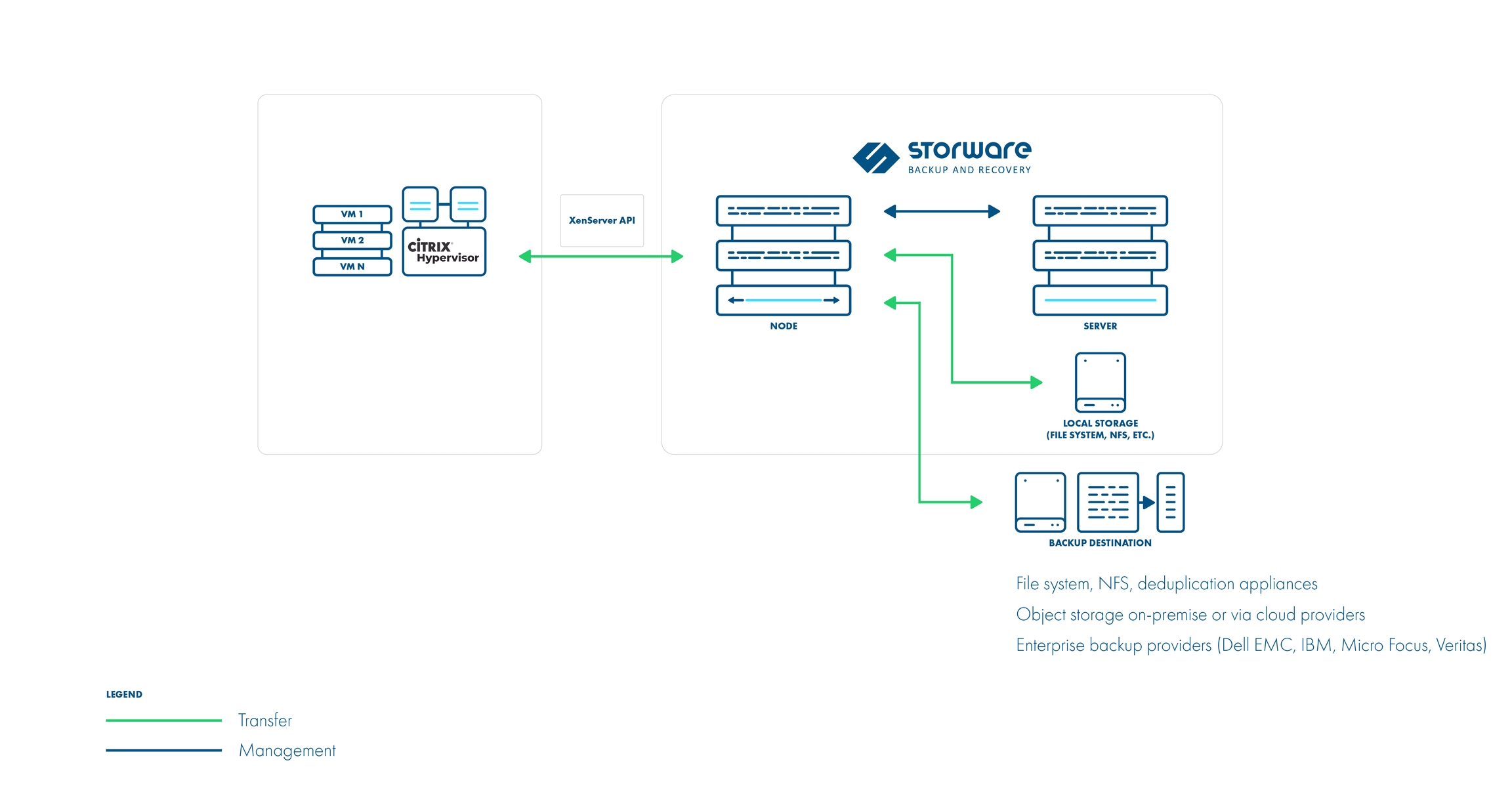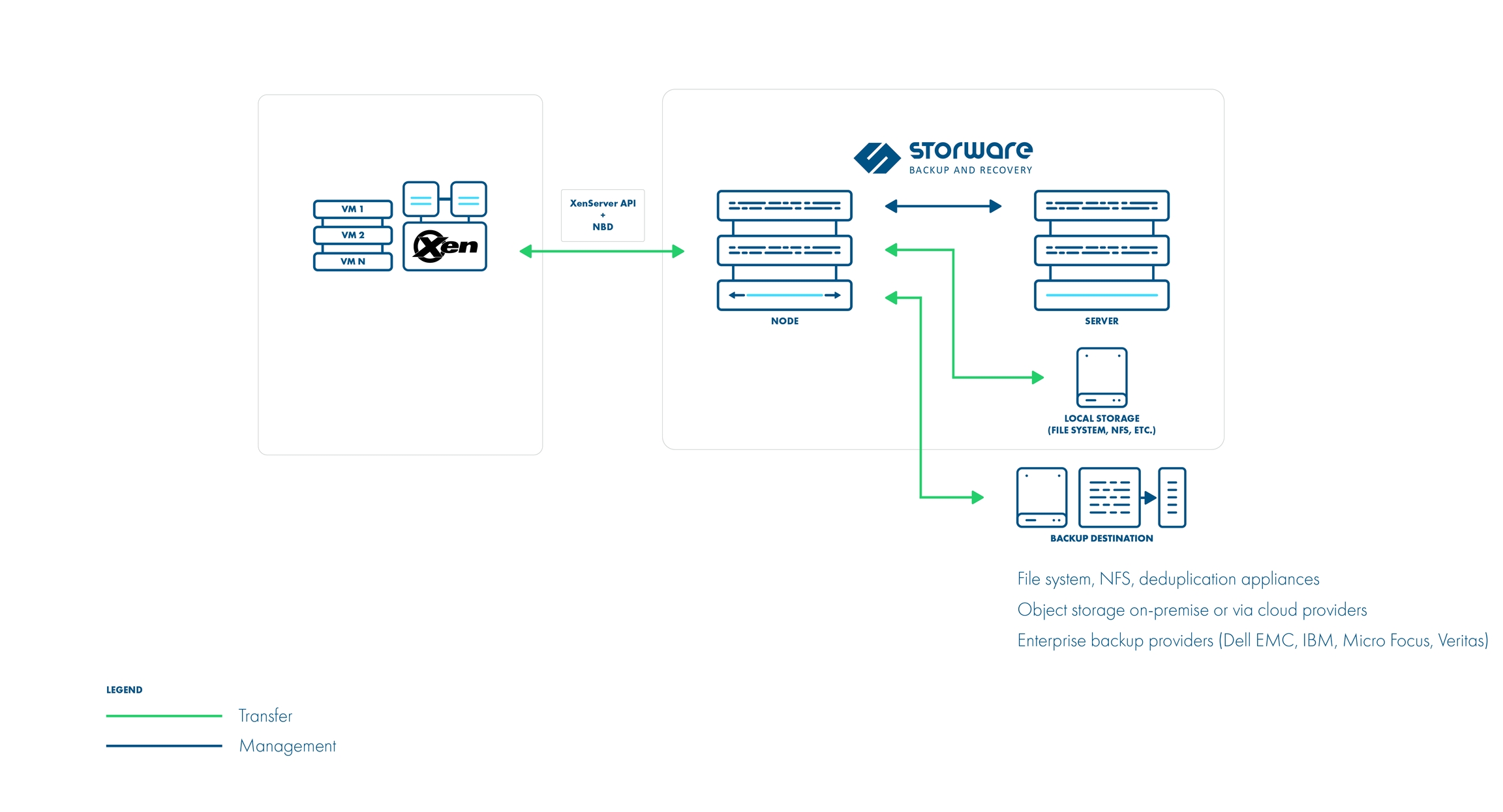Citrix Hypervisor (XenServer)
Backup Strategies
XVA-based
In this strategy, the VM is exported as a single XVA bundle containing all of the data. Incremental backup is also supported. Data is transferred directly from the XenServer API without the need to set up anything on the hosts.

Backup Process
crash-consistent snapshot using hypervisor's API only for full backups
optionally quiesced snapshot can be done if enabled and guest tools installed inside - if quiesced snapshot has been failed we are doing regular one
optional application consistency using pre/post snapshot command execution
data export directly from the hypervisor using hypervisor's API - both full (XVA) and delta (VHD for each disk)
full backup (XVA) contains metadata
snapshot taken with full backup is kept on the hypervisor for the next incremental backup - if at least one schedule assigned to the VM has backup type set to incremental
incremental backups are cumulative (all data since last full backup)
restore recreates VM from XVA, and then applies changes from each incremental backup using Hypervisor APIs
Changed-Block Tracking
In this strategy, the VM is exported using XenServer API (full backup) and the Network Block Device service (NBD, incremental backups) on the XenServer hosts. The CBT feature in Citrix XenServer 7.3+ may require an additional license. The resulting backup has separate files for each disk + metadata, so you also have the option to exclude specific drives.

Backup Process
crash-consistent snapshot using hypervisor's API
optionally quiesced snapshot can be done if enabled and guest tools installed inside - if quiesced snapshot has been failed we are doing regular one
optional application consistency using pre/post snapshot command execution
CBT enabled during full backup on each disk if it wasn't done earlier
metadata exported from API
full backup - each disk exported from API (RAW format)
incremental backup - each disk queried for changed blocks and which are exported over NBD
last snapshot kept on the hypervisor for the next incremental backup - if at least one schedule assigned to the VM has backup type set to incremental
restore recreates VM from metadata using API and imports merged chain of data for each disk using API
Change Block Tracking setup
Citrix introduced the CBT mechanism in XenServer 7.3. In order to enable CBT backups, the following requirements must be met:
Citrix XenServer 7.3 or above must be used - note that CBT is a licensed feature
The NBD server must be enabled on the hypervisor
The NBD client and NBD module must be installed on Storware Backup & Recovery Node
Notes on restore
When image-based backups (XVA) are used - Storware Backup & Recovery restore VMs as templates and renames them appropriately after the restore
When separate disk backups are used:
if there is already a VM in the infrastructure with the UUID of the VM being restored (check
presentflag in VM list) - Storware Backup & Recovery restores it as a new VM (MAC addresses will be generated)otherwise Storware Backup & Recovery attempts to restore the original configuration including MAC addresses
NBD Server setup (on XenServer)
Get the Network UUID that you intend to use for communication with Storware Backup & Recovery - run on the XenServer shell:
[root@xenserver-cbt ~]# xe network-list uuid ( RO) : e16b4e34-47d4-9a6e-371b-65beb7252d69 name-label ( RW): Pool-wide network associated with eth0 name-description ( RW): bridge ( RO): xenbr0 .......... uuid ( RO) : 244a2fa7-ae7c-e45c-819a-44cecf51e8fa name-label ( RW): Host internal management network name-description ( RW): Network on which guests will be assigned a private link-local IP address which can be used to talk XenAPI bridge ( RO): xenapiFor example:
e16b4e34-47d4-9a6e-371b-65beb7252d69Enable the NBD service on your hypervisor:
xe network-param-add param-name=purpose param-key=nbd uuid=<network-uuid>
NBD Client setup (on Storware Backup & Recovery Node)
Storware Backup & Recovery comes with a pre-built RPM and modules for CentOS 7 distribution.
Go to the NBD directory:
cd /opt/vprotect/scripts/nbdUse
yumto install the NBD client:yum -y install nbd-3.16.1-1.el7.centos.x86_64.rpmIf your Linux does not have the NBD module installed you may try to build one yourself (there is a script for Red Hat based distributions that downloads the kernel, enables the NBD module, and builds it) or use an already provided module:
you can compile the module by running:
./compile_nbd_module.shif you have Centos 7, you also may use a pre-built module (for CentOS 7.4.1708 with kernel 3.10.0-693.5.2) - which is
nbd.ko
Enable the module by invoking the script (the following command will either use a module in your kernel or copy the provided
nbd.ko):./enable_nbd.shVerify that you have
/dev/nbd*devices available on your Storware Backup & Recovery node host:[root@localhost nbd]# ls /dev/nbd* /dev/nbd0 /dev/nbd1 /dev/nbd10 /dev/nbd11 /dev/nbd12 /dev/nbd13 /dev/nbd14 /dev/nbd15 /dev/nbd2 /dev/nbd3 /dev/nbd4 /dev/nbd5 /dev/nbd6 /dev/nbd7 /dev/nbd8 /dev/nbd9Restart your Storware Backup & Recovery Node:
systemctl restart vprotect-node
Limitations
VM migration between clusters is not supported.
Cloning VM to another cluster is not supported.